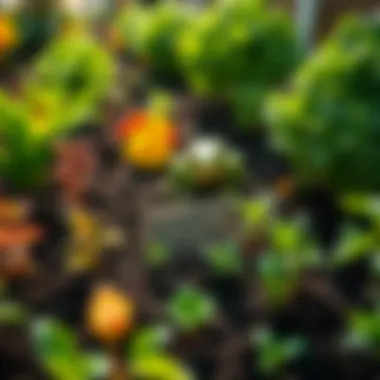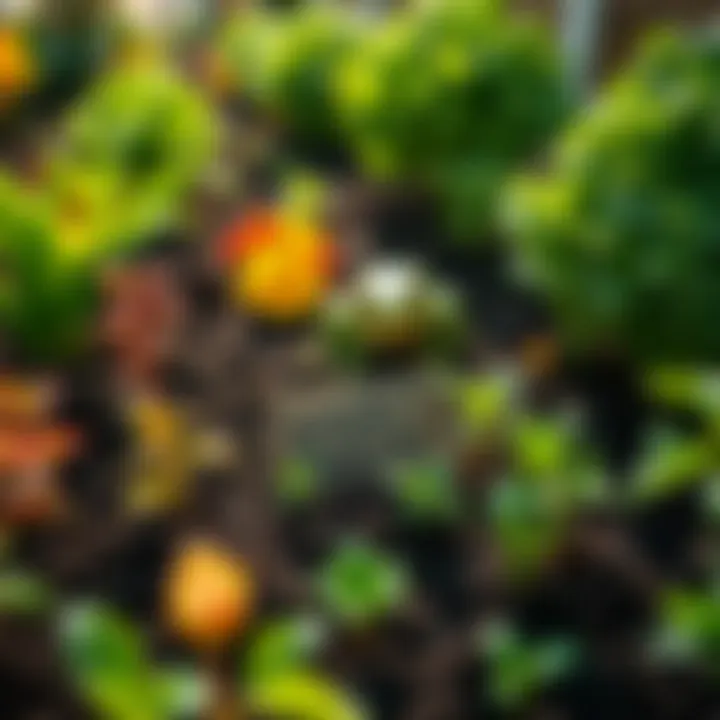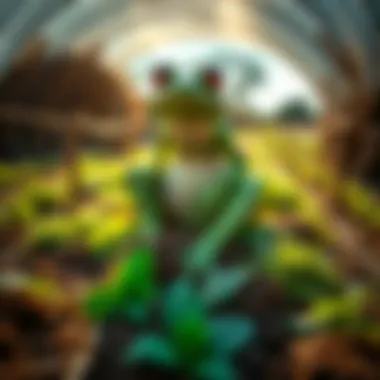Exploring Happy Frog Compost for Soil Health


Intro
In an age where sustainable farming practices are increasingly at the forefront of agricultural discourse, compost has emerged as a lifeline for soil health. Among the various types of compost available, Happy Frog compost has carved out a notable niche. As farmers and gardening enthusiasts alike delve into strategies for optimal plant growth, understanding this particular compost is more than just a passing interest.
Happy Frog compost, crafted from organic materials through a meticulous process, stands out for its richness in nutrients and the beneficial microbes it harbors. This article aims to illuminate the many dimensions of Happy Frog compost, from its foundational components to its practical application in boosting soil fertility. Whether you are a green-thumbed novice or a seasoned agricultural practitioner, delving into the world of Happy Frog will surely enhance your understanding of sustainable horticulture.
While exploring its composition, you'll encounter insights into the microbial life that brings soil to life—transforming it into a thriving ecosystem capable of supporting robust plant growth. Then, we will traverse through practical applications, understanding how best to incorporate this organic matter into various farming techniques. Furthermore, we will address the environmental implications of using Happy Frog compost, ensuring that every scoop contributes positively to our planet's health.
Get ready for an engaging exploration into the realm of Happy Frog compost, where soil health meets sustainable practices!
Understanding Happy Frog Compost
Understanding Happy Frog Compost is crucial for anyone looking to improve soil health and enhance plant growth. This unique compost offers numerous benefits, including increased soil fertility, improved structure, and better water retention, all of which contribute to a thriving garden or farm. Delving into what makes Happy Frog compost distinct not only informs the user about its practical applications but also sets the stage for recognizing its importance in sustainable agriculture.
Definition and Overview
Happy Frog Compost can be defined as a specialized type of organic matter that has undergone specific processes to achieve a rich blend of nutrients. Made primarily from natural sources, it combines elements such as plant materials, animal by-products, and various organic waste. This compost is particularly rich in beneficial microbes and essential nutrients, which are vital for the growth of healthy plants. The formulation process is tailored to ensure that it retains moisture while also providing the soil with qualities to foster a vibrant ecosystem beneath the surface. An understanding of its definition invites farmers and gardening enthusiasts alike to see the practical implications of using this compost in their agricultural practices.
Historical Context
The journey of Happy Frog Compost begins with the broader context of organic farming and composting practices. Historically, many civilizations have recognized the value of compost for enriching soil. From ancient Egypt, where farmers utilized animal dung mixed with straw, to contemporary sustainable farming movements, each era has embraced the significance of compost. Happy Frog Compost, while rooted in traditional practices, emerged as a response to modern agricultural challenges. As farmers sought to reduce reliance on chemical fertilizers, the demand for organic solutions grew.
In the past few decades, with the rise of ecological awareness and sustainable farming methods, formulations like Happy Frog were developed to meet these evolving needs. Its formulation considers not only nutrient content but also the microbial activity that is essential for optimal soil health. By exploring this historical backdrop, one can appreciate the evolution of soil enhancement techniques and how they have shaped the development of products like Happy Frog Compost.
"The foundational principle behind any successful farming is nurturing the soil, and compost is its heart."
Thus, understanding both its definition and historical context provides a comprehensive view of Happy Frog Compost, illustrating how it fits into a larger narrative of agricultural progress.
Composition of Happy Frog Compost
The composition of Happy Frog Compost is a crucial aspect to explore, as it serves as the backbone for understanding its efficacy and benefits in enhancing soil health. By examining the specific elements that make up this rich organic material, we can appreciate not only how it contributes to soil fertility but also the best practices for its use in both professional agriculture and home gardening. The mixture of plant materials and animal by-products offers a balanced nutrient profile that promotes robust microbial activity, crucial for ideal growing conditions.
Organic Matter Sources
Plant materials
Plant materials are a key ingredient in Happy Frog Compost. These include various organic waste products such as leaves, grass clippings, and vegetable scraps. The richness of plant materials lies in their high carbon content, providing energy for microorganisms during the decomposition process. This process aids in creating a nutrient-dense compost that nourishes the soil.
One unique aspect of plant materials is their diversity. Different plants contribute varying levels of nutrients, thus enriching the compost with a broad spectrum of essential elements like nitrogen, phosphorus, and sulfur. This variety makes plant materials an excellent choice in establishing a worm-friendly environment, which further enhances mobility and nutrient availability in the soil.
However, an understanding of the types of plant materials used is essential. Some materials may break down quickly while others take longer, potentially causing uneven nutrient release during the growing season. Balancing this factor is crucial for optimizing plant growth.
Animal by-products
On the other hand, animal by-products bring another layer of richness to Happy Frog Compost. Common sources include poultry litter, manure from yard animals, and fish waste. One primary advantage of these materials is their concentrated nutrient content, especially nitrogen, essential for plant development. Among the various options, chicken manure is often highlighted for its beneficial properties, making animal by-products a popular choice for improving soil health.
A unique feature of using animal by-products is their contribution to the microbial community within the compost. They provide not just nutrients but also support the growth of beneficial bacteria and fungi essential for breaking down organic matter. However, there's a caveat to consider: the risk of pathogens that sometimes accompany animal waste. Proper composting methods and temperatures must be maintained to mitigate these risks, ensuring a safe product for gardening and agriculture.
Microbial Activity
Microbial activity is pivotal when discussing the composition of Happy Frog Compost. The presence of diverse communities of bacteria and fungi contributes to the compost's effectiveness in nutrient cycling and plant health. This microbial biodiversity aids in the degradation of organic matter and the synthesis of vital nutrients that plants can readily absorb.
Bacterial and fungal presence


The bacterial and fungal presence within Happy Frog Compost is a significant factor in its success. Bacteria, often faster to respond in the composting process, work to break down organic materials, while fungi play a crucial role in forming a mycelium network that further processes complex organic substrates. This combination ensures that nutrients are released in a form plants can utilize.
Another characteristic to note is the synergistic effect between these microorganisms—this relationship not only boosts nutrient availability but also enhances the microbial resilience against diseases, creating a more robust ecosystem. However, any imbalance in microbial populations caused by improper compost management can lead to inefficiencies and even the presence of pathogens.
Role in nutrient cycling
The role of microbial activity in nutrient cycling cannot be overstated. When Happy Frog Compost is applied to the soil, these microorganisms facilitate the conversion of organic forms of nitrogen and phosphorus into inorganic forms suitable for plant uptake. This process is vital for maintaining optimal soil fertility and ensuring sustainable crop yields.
The importance of nutrient cycling also emphasizes how Happy Frog Compost supports not just immediate plant needs but also long-term soil health. While there are challenges like nutrient leaching during heavy rains, proper application methods can help mitigate these issues, ensuring the nutrients remain available to plants over time.
"Healthy soil is teeming with microorganisms; they are essential for a thriving agricultural system."
In summation, the composition of Happy Frog Compost, with its blend of plant materials, animal by-products, and the vibrant microbial community it supports, illustrates its comprehensive approach to enhancing soil health. Understanding these components provides a clearer picture of how to effectively use this compost in various gardening and agricultural practices.
Benefits of Using Happy Frog Compost
Using Happy Frog compost offers a myriad of benefits that can significantly enhance soil health and promote robust plant growth. Essentially, it serves as a powerhouse of nutrients and organic matter, making it a vital amendment for both agricultural and gardening endeavors. By diving into aspects like soil fertility enhancement, water retention, and microbial health, we start to uncover the many reasons this product is so valuable.
Soil Fertility Enhancement
Nutrient availability
The nutrient availability in Happy Frog compost is remarkable, featuring a blend of nitrogen, phosphorus, potassium, and vital micronutrients that crops require for optimal growth. This blend enhances the fertilization process and allows for the gradual release of nutrients into the soil, ultimately offering plants access to what they need without overwhelming them. A key characteristic is the slow-release format; unlike synthetic fertilizers that can cause nutrient burn, Happy Frog compost ensures that nutrients are released in sync with the plant's needs. This not only means less waste but also fosters a healthier plant environment. The unique feature of this nutrient availability is its orchaic balance; it assists in avoiding nutrient leaching and keeps the soil adequately nourished over time.
Improvement of soil structure
Happy Frog compost also brings about a significant improvement in soil structure, transforming it from a compacted, lifeless medium into a thriving habitat for organisms and plants. This is crucial since a well-structured soil promotes aeration and root penetration, which leads to healthier plant growth. The crumbly texture of Happy Frog compost aids in creating air pockets, thus optimizing both water drainage and retention simultaneously. One aspect of this enhancement is that improved soil structure can lead to increased resilience against erosion and better overall soil stability. However, it's worth noting that the effectiveness of this improvement can vary based on factors like initial soil condition and compost application rates.
Water Retention and Drainage
When it comes to water retention, Happy Frog compost excels. It acts like a sponge, helping soil to retain moisture, which is especially vital in periods of drought. This improves the overall irrigation efficiency by reducing the frequency of watering required. On the flip side, this retention capacity also aids in preventing soil erosion, ensuring that nutrients are not washed away during heavy rains. However, care must be exercised in application; overusing compost can sometimes lead to overly saturated soil, impacting drainage negatively.
Microbial Health
Diversity of microbial populations
One of the standout features of Happy Frog compost lies in its rich array of microbial populations. These microorganisms play an unsung role in breaking down organic matter, facilitating nutrient cycling, and improving soil health. The diversity in microbial populations is essential; a variety of species corresponds to a robust ecological balance within the soil, enabling it to recover more efficiently from disturbances. This adaptability makes Happy Frog compost a popular choice among farmers and gardeners alike. Notably, a richer diversity leads to a healthy soil ecosystem, which can be a defining factor in plant vitality and yield. Further, while there are many composting methods out there, none can recreate the intricate web of life like Happy Frog does, underscoring its necessity in soil management practices.
Impact on plant health
The impact of Happy Frog compost on overall plant health cannot be overstated. Through enhancing microbial life, it fosters conditions that allow plants to access nutrients more efficiently. Healthy plants can better resist diseases and pests, thanks to a stronger immune system developed through improved nutrient uptake. This advantage signifies that using Happy Frog compost is more than just a choice; it's about ensuring the longevity and productivity of crops. A unique feature lies in the interconnectedness of plant and soil health; when one flourishes, the other tends to follow suit, forging a sustainable cycle of growth that benefits everyone involved in horticulture or farming.
Application of Happy Frog Compost
The practical application of Happy Frog Compost represents a cornerstone of both agricultural practices and home gardening strategies. This section delves into how this nutrient-rich organic material can be effectively used to enhance plant growth, soil structure, and overall garden health. With various applications spanning the farm and backyard alike, understanding where and how to utilize this compost allows both hobbyists and farmers to tap into its myriad benefits, ultimately supporting their endeavors toward a sustainable growing environment.
In Agricultural Practices
Crop cultivation
When we talk about crop cultivation, incorporating Happy Frog Compost emerges as a worthwhile venture. This compost is packed with essential nutrients, crucial for crops to thrive without needing synthetic fertilizers that could potentially harm the soil over time. The key characteristic of this approach is its ability to promote healthy root development, encouraging crops to grow robustly in nutrient-rich environments. A notable aspect is that it organically fosters a diverse ecosystem within the soil, which in return supports better crop yields.
Moreover, the unique feature of utilizing Happy Frog Compost in crop cultivation lies in its capacity to enhance soil fertility while increasing the organic matter content of the soil. This becomes particularly advantageous during seasons when nutrient depletion is a common challenge. Farmers can find that crops grown in enriched soils often display improved resistance to pests and diseases, establishing resilience in the face of fluctuating weather conditions. Despite these benefits, a farmer must consider the initial costs and labor involved in compost application, though many will argue that long-term gains outweigh these factors.


Soil amendment techniques
Exploring soil amendment techniques using Happy Frog Compost unveils another layer of its utility in agriculture. Amending soil with compost not only enriches it but also helps adjust pH levels, a critical aspect for many crops to flourish. This practice has gained popularity due to its sustainable nature, reducing reliance on chemical amendments while enhancing long-term soil health. The incorporation of compost effectively supports key microbial processes, fostering a healthy environment for nutrient release.
One intriguing aspect of soil amendment techniques is the ability to tailor applications based on specific crop requirements. Different soils present unique challenges, and Happy Frog Compost can be mixed with various ingredients, such as vermiculite or peat moss, to create the optimal conditions for different plants. While some may note that achieving the right mix could require some experimentation, the resulting positive impact on soil structure and fertility is often worth the effort.
In Home Gardening
Container gardening
Container gardening represents a stunning entry point for urban dwellers and those with limited space. By employing Happy Frog Compost, gardeners can breathe life into their pots, trays, or boxes, supplying an enriching environment that promotes healthy plant growth. The key characteristic of this method is its adaptability; whether you’re growing herbs on a balcony or tomatoes in a small backyard, using compost enhances nutrient retention and aeration, creating a thriving ecosystem in even the smallest of spaces.
A distinct feature of container gardening with Happy Frog Compost is its lightweight nature which makes it easy to handle and transport. The enhanced drainage properties of the compost prevent waterlogging, which often leads to root rot, thus increasing the chances of successfully nurturing plants. Though gardeners might need to replenish compost more frequently than in traditional beds, the short-term effort can result in vibrant and bountiful yields.
Raised bed applications
Using Happy Frog Compost in raised bed applications opens up a practical avenue for many home gardeners seeking to optimize their soil health. Raised beds offer a controlled environment, making them an ideal canvas for showcasing the benefits of this premium compost. The intriguing aspect is the rapid improvement in soil structure that can be realized; the compost introduces beneficial microbes while maintaining moisture, promoting overall plant vitality.
Unlike traditional gardening methods, raised beds allow for a simpler management of soil composition, enabling users to adjust and enhance the raised bed mixture with Happy Frog Compost more easily. These beds, elevated from the ground, also help in reducing soil compaction while improving drainage. While the initial investment in creating raised beds can seem high, the sustainability and increased yield potential they provide justify the costs over time, highlighting the long-term value of proper compost usage.
Engaging with Happy Frog Compost across these various applications presents a significant opportunity for anyone aiming to improve their growing environment, whether on a large agricultural scale or within the confines of a small garden. It is a tool that embodies both practicality and sustainability, serving as a bridge towards healthier soil and, consequently, healthier plants.
Environmental Considerations
In the context of Happy Frog compost, examining environmental considerations is essential to understanding its broader implications in sustainable agriculture and horticulture. The cultivation and utilization of compost do not merely impact the immediate soil where it is applied; rather, they resonate through ecosystems, influencing various environmental processes and promoting a more holistic approach to farming practices. Addressing these factors ensures that enhancing soil health also contributes to ecological stability and resilience.
Sustainability of Composting Operations
The sustainability of composting operations is pivotal. Happy Frog compost is not just a product but results from dynamic processes that recycle organic materials, thus reducing waste while nourishing the soil. Proper composting practices not only help in diverting organic waste away from landfills but also enhance the carbon sequestration potential of soils. This, in turn, can play a significant role in mitigating climate change—a concern recognized across agricultural sectors.
Additionally, sustainable composting operations are typically designed to minimize environmental impact. Incorporating various materials—from plant residues to animal manures—encourages nutrient cycling without depleting resources. Farmers can benefit from using Happy Frog compost since it provides a constant supply of essential nutrients while promoting a closed-loop system. This method fosters better soil health over time and cultivates a robust ecosystem.
Impact on Biodiversity
Promoting soil organisms
Promoting soil organisms through the application of Happy Frog compost creates a rich habitat for beneficial microbes, fungi, and other microorganisms crucial for nutrient exchange and plant health. A healthy microbial community enhances soil structure by breaking down organic matter and improving aeration and retention of moisture. Key characteristics of this approach include the diversity and abundance of soil organisms, which can lead to improved nutrient availability for crops. This aspect is a cornerstone in organic farming practices, making Happy Frog compost a highly sought-after choice.
The unique feature of focusing on soil organisms is their symbiotic relationships with plants. Many plants depend on mycorrhizal fungi to absorb water and nutrients more efficiently. This cooperation can result in significantly better crop yields, contributing to a productive agricultural system. Moreover, promoting soil organisms is often associated with decreased reliance on chemical fertilizers, which is increasingly seen as a responsible environmental practice.
Effects on local ecosystems
When examining the effects on local ecosystems, Happy Frog compost contributes positively by enhancing soil quality and, consequently, plant diversity. Healthier soils support a range of plant species, which in turn attract various fauna, including beneficial insects and pollinators. This complex interrelation fosters a thriving ecosystem that provides essential services such as pest control and pollination. Furthermore, it plays a role in mitigating erosion and improving water quality by filtering runoff.
One of the key characteristics of improving local ecosystems is resilience. Rich composted soils can better withstand extreme weather events such as droughts or deluges, as they retain moisture while allowing excess water to drain. While there may be challenges associated with implementing composting practices—like the initial investment required or the need for education on proper methods—the long-term benefits to local ecosystems cannot be understated. Encouraging biodiversity often leads to a more balanced and sustainable agricultural practice.
Happy Frog compost is not merely about enriching the soil; it’s about nurturing a robust ecosystem that pays dividends in sustainability.
In summary, environmental considerations surrounding Happy Frog compost highlight its role in fostering sustainability while simultaneously enhancing biodiversity. By focusing on effective composting operations and their impact on local ecosystems, it becomes evident that this organic solution supports not only crop health but also the vitality of the environments in which they grow.
Challenges and Limitations
While Happy Frog Compost undoubtedly holds significant benefits for soil health, it's essential to approach its utility with a critical eye. Understanding the challenges and limitations is a fierce necessity for anyone looking to maximize the effectiveness of their gardening or farming practices. Among the most notable impediments are nutrient variability and regulatory considerations associated with compost use.


Nutrient Variability
Nutrient variability in Happy Frog Compost can fluctuate widely based on several factors, including the original organic materials, environmental conditions during the composting process, and the specific microorganisms at play. Unlike synthetic fertilizers, which often come with guaranteed nutrient concentrations, compost often provides a more unpredictable nutrient profile.
- Organic Materials: The type of organic materials used in the composting process greatly influences the nutrient levels. For instance, compost made from vegetable clippings may have different nitrogen and phosphorus levels compared to compost enriched with manure or other animal by-products.
- Environmental Conditions: Factors such as humidity, temperature, and the duration of the composting process can significantly affect nutrient breakdown and availability. When conditions are not optimal, essential nutrients may not become readily available for plant uptake.
- Microbial Activity: The presence and balance of microbial populations will also play a decisive role in nutrient cycling. Some microorganisms excel in breaking down more challenging organic materials, while others may not contribute as effectively, leaving gaps in the nutrient profile.
In essence, it becomes crucial for users of Happy Frog Compost to conduct soil tests before and after application to better understand the nutrient composition. Such a proactive measure can prevent issues like nutrient deficiencies, ensuring that crops receive the necessary sustenance to thrive.
Regulatory Considerations and Use
Navigating regulatory considerations when using Happy Frog Compost is another layer that can pose challenges for farmers and gardeners alike. Various regulations govern the production, labeling, and application of compost, designed to ensure safety and efficacy. Here are some key points to bear in mind:
- Quality Standards: Many regions have established quality standards that compost must meet, including limits on pathogen levels and contaminants. These standards aim to ascertain that compost is safe for agricultural use and won't introduce harmful elements into the soil.
- Organic Certification: For those focused on organic farming, the use of compost must fall in line with USDA organic standards. Not all composts meet these criteria, so confirming compliance is vital for farmers aiming for organic certification.
- Application Rates: Regulatory bodies might also regulate the permissible application rates for compost, particularly in crops where nutrient runoff could lead to environmental issues. Understanding these guidelines ensures sustainable use of Happy Frog Compost, aligning agricultural practices with environmental protections.
"Being forewarned is being forearmed; the right knowledge leads to the right action."
For those exploring compost options, combining the benefits with an understanding of potential hurdles will enable a more balanced and successful approach to soil health management.
Comparing Happy Frog Compost with Other Products
In the realm of organic gardening and sustainable agriculture, choosing the right compost product can be pivotal. Happy Frog Compost brings unique qualities to the table, yet it is essential to compare this option against others in the market. By understanding these comparisons, growers can make informed decisions that best suit their soil health goals.
Commercial Compost Alternatives
When considering commercial compost products, several alternatives warrant discussions. Many brands are rooted in organic practices, but they may differ significantly in nutrient profiles, texture, and microbial content. Some notable alternatives include:
- Black Gold: Known for its versatile use, Black Gold combines compost with other organic materials, enhancing its ability to retain moisture.
- Worm Castings: This product, derived from the droppings of worms, is often seen as a powerhouse in terms of nutrient density and is prized for its ability to promote microbial life.
- FoxFarm Happy Frog: Some might view this as a more general compost product. It’s specially formulated with beneficial microbes, yet it often lacks the depth of natural composting seen in Happy Frog Compost.
One key aspect to consider with commercial alternatives is the cost. Some products may carry a hefty price tag without providing enhanced benefits over Happy Frog. It’s crucial for gardeners and farmers to scrutinize product labels, clarify the ingredient origins, and gauge the suitability for their specific soil conditions.
Furthermore, not all composts are created equal when it comes to nutrient cycling. Happy Frog not only contains essential macro and micronutrients but also houses a rich diversity of microbes that can withstand various environmental conditions.
Homemade Compost Solutions
The appeal of homemade compost lies in its accessibility and adaptability. Many gardeners engage in composting their kitchen scraps and yard waste to create a sustainable solution tailored to their needs. However, achieving the same quality as Happy Frog can be challenging. Some considerations in homemade composting include:
- Material Variety: Mixing greens (nitrogen-rich materials) and browns (carbon-rich materials) is essential. Common kitchen scraps include vegetable peels, coffee grounds, and eggshells, while dry leaves and cardboard contribute to the carbon content.
- Composting Timeframe: Homemade compost can take anywhere from a few months to over a year to fully mature, depending on factors such as moisture and aeration. In contrast, Happy Frog Compost provides an instantly usable product that has been pre-composted and ready for application.
- Microbial Diversity: Over the years, many novice composters may find that their homemade variants lack the robust microbial community present in commercial products like Happy Frog. The success of soil health is deeply rooted in this microbial partnership, fostering nutrient availability for plants.
Ultimately, while Happy Frog Compost excels in certain areas, homemade solutions offer flexibility and budget-friendliness. Each grower must weigh the benefits of immediate nutrient-rich compost against the more personalized, albeit variable, outcomes of homemade composting.
"Choosing the right compost isn’t just about the product; it’s about what works best for your soil and your plants."
End and Future Directions
As this exploration of Happy Frog compost wraps up, it's clear that understanding its role in enhancing soil health and fertility is essential for anyone in the agricultural space. The topic is not merely a matter of interest, but rather a pivotal element in the quest for sustainable farming practices. Happy Frog compost, with its rich organic composition, offers numerous benefits, from improving soil structure to increasing nutrient availability.
Summary of Key Points
In summarizing the key takeaways:
- Nutrient-Rich Composition: Happy Frog compost stands out for its potent mix of organic materials that foster nutrient availability.
- Microbial Activity: The microbial life found in Happy Frog compost enriches the soil, fostering robust plant growth.
- Water Management: Enhanced water retention properties contribute significantly to improved drought resilience in crops.
- Versatile Applications: Whether in commercial agriculture or home gardening, its application is versatile, catering to varied planting needs.
- Sustainability Focus: Utilizing Happy Frog compost aligns with sustainable farming practices, ensuring minimal environmental impacts.
The importance of employing such a compost isn't just confined to immediate agricultural goals; the long-term benefits compound over seasons. By leveraging Happy Frog compost, there’s a notable shift towards healthier ecosystems, more bountiful harvests, and improved biodiversity.
Research Opportunities
Looking ahead, there are ample avenues for further research. Understanding the specific impacts of Happy Frog compost on various plant species could yield significant insights. Here are potential research domains:
- Soil Microbial Dynamics: Delving deeper into how this compost affects microbial communities over time could provide valuable data.
- Crop-Specific Studies: Researching how different crops respond to Happy Frog compost compared to other fertilizers might reveal optimized agricultural practices.
- Longitudinal Studies: Conducting long-term studies to evaluate the lasting effects of Happy Frog compost on soil health and productivity.
- Comparative Analysis: Exploring how Happy Frog compost stands against other organic fertilizers in terms of environmental impact and efficacy.
By placing emphasis on these areas, researchers will not only enhance the academic foundation of composting practices but also contribute practical, real-world solutions for future agricultural endeavors. Focusing on these opportunities can lead to a harvest of benefits that stretch far beyond individual gardens and farms; it's a chance to shape the future of sustainable agriculture.



